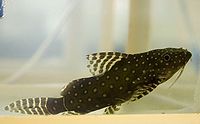Angelicus (Synodontis angelicus)
From The Aquarium Wiki
(Redirected from Angelicus)
Angelicus
Synodontis angelicus
246 Litres (65 US G.)
22.9-25.4cm (9-10 ")
Freshwater
6.0 - 8.0
23 -27 °C (73.4-80.6°F)
6-10 °d
1:1 M:F
5-8 years
Family
Mochokidae
Contents
Additional names
- Angelicus, Angel Squeaker, Angelic Synodontis, Polkadot Catfish, Angel Catfish, Polkadot Squeaker, Angelicus Cat
Additional scientific names
- Synodontis tholloni, Synodontis robbianus, Synodontis angelicus zonatus, Synodontis werneri, Synodontis angelica
Origin[edit]
- Africa: Congo River basin except the Zambian Congo and the central forest, but including Pool Malebo (Stanley Pool) and the drainages of the Kasai and Ubangi.
Sexing[edit]
- Difficult without observing the underside of the fish out of the water. Males tend to be more slender than females however.
Tank compatibility[edit]
- These fish can be territorial towards their own kind, but provided the tank is large enough, can be kept in groups. They do best in large community tanks with African Cichlids or Congo Tetras.
Diet[edit]
- These fish do best on a varied diet of catfish pellets, flake foods, pellets, prawns and other such foods as bloodworm and Ghost Shrimp.
Feeding regime[edit]
- Feed once or twice a day.
Environment specifics[edit]
- Prefers a spacious tank with hiding places, especially a good cave to call its own. Prefers a rocky set up to bogwood.
Behaviour[edit]
- A generally peaceful catfish as long as it's kept with fish of similar size or larger, smaller fish may be seen as prey.
Identification[edit]
- The body of this Synodontis is long with a rounded snout and three sets of barbels. The colour of the Angelicus can vary, generally the base colour is dark blue-black with white spots irregularly scattered over the body. The number of spots will vary from one fish to another. The underside of the fish tends to be pale. The adipose fin is spotted, the other fins have dark transverse bands. An uncommon regional variation has few spots on the body and no spots on the head with thin white transverse bars, a yellow spotted variant has also been seen.
Pictures[edit]
External links[edit]
- Fishbase (Mirrors:
 )
)

